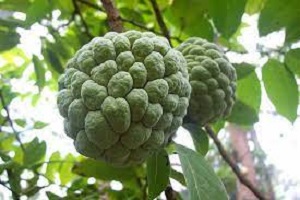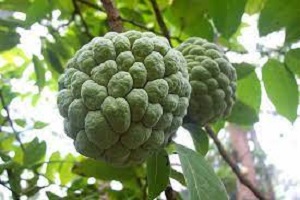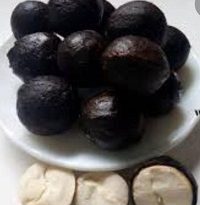Sugar Apple Benefits, Nutrition, and Ways to Consume
Sugar Apple Benefits, Nutrition Value, and Ways to Consume

- What Are the Benefits of Sugar Apples?
- Uses and Health Benefits of Sweetsop or Sugar Apple Fruit Trees
- Health Benefits of Sugar Apple for Beauty and Treatment
Sugar Apple Benefits, Nutrition Facts ~ an Overview
Sugar apple is a fruit with many different names. Some people refer to it as sugar pineapple, cherimoya, or sweetsop. Whatever you call it, you’re referring to the cone-shaped fruit with scaly, greenish skin and soft, juicy pulp.
The sugar apple is a member of the Annonaceae family and is native to South America. Annona squamosa is the scientific name for sugar apple.
Sugar apple, like other tropical fruits, has a refreshing taste similar to banana and pineapple and is best eaten chilled, sometimes with a spoon due to its creamy inside, making it a popular ingredient in smoothies and ice cream.
Aside from its sweet fflavor sugar apple is a very healthy fruit that is high in nutrients and minerals.
It contains vitamins C, calcium, magnesium, potassium, niacin, and other minerals. It also contains a lot of antioxidants and phytochemicals.
What Is Sugar Apple?
Sugar apples are heart-shaped fruits. It is the most commonly eaten part of the sugar apple tree and grows on thick, woody stalks.
It has a thick, hard outer surface that is covered in scaly greenish skin.
The fruit is easily identified by the knobby segments on its exterior, which separate and reveal the inner section once ripe.
The inner flesh is juicy and fragrant, and it ranges in ccolorfrom light yellowish-green to purple. A typical fruit contains 20 to 38, and sometimes,even more, seeds.
The sugarapple is a member of the Annonaceae family. Its tree can be found in the West Indies and South America.
Today, most tropical and subtropical regions of the world, including Bermuda, Mexico, Southern Florida, and the Bahamas, grow the fruit extensively.
Many Asian countries, including India, China, and the Philippines, are also big fans.
Annona squamosa is the scientific name for sugar apple. It’s known as “fruta do conde do mato” in Brazil, which translates to “fruit of the woodland count.” You’ve probably also heard of its other regional names, such as sweetsop, scaly custard apple, anon, and bullock’s heart
Apple Sugar Fruit ~ Sugar Apple Benefits
The fruit resembles a pinecone and is shaped like a hand grenade. The skin is rough and aale green colour. Some varieties are red, which makes them stand out more.
Apple Sugar Taste
The pulp is creamy white, tender, and delicate, with a custard-like fflavor Sugar-apple fruit is typically consumed fresh or as an ingredient in cakes, beverages, and shakes.
It is high in ccarbohydratesand protein, as well as vitamin C, B, calcium, potassium, iron, magnesium, and phosphorus, but it is high in calories.
How to Eat a Sugar Apple
Before you can eat the fruit, it must be ripe and soft.
- You can eat it by scooping the pulp with a tablespoon or by pulling the fruit segments one by one.
- FThe fruitpulp is consumed fresh or used to make sorbet or juice beverages.
- Sherbet, ice cream, and shakes are all fflavoredwith pulp.
- In Malaysia, fthe lesh is mixed with ice cream or blended with milk to make a drink.
- In the West Indies, fruit is fermented to make a type of cider.
- For breakfast, combine it with cereal. To add fflavor add shredded coconut or nuts.
- When combined with milk, this fruit can be used to make shakes or cool beverages.
- It can be added to side dishes like fruit coleslaw to boost the sweetness.
Sugar apple tastes best when served cold, so chill it for at least three hours before serving.
What Are the Nutrition Facts of Sugar Apples? Sugar Apple Benefits
The sugar apple is a very healthy fruit that is high in vitamins, minerals, ffiber and energy. Iron, manganese, magnesium, calcium, potassium, and phosphorus are abundant.
It contains high levels of vitamin A, B1, B2, B3, B5, B6, and B9, as well as slightly more vitamin C than grapefruit. It also contains a lot of phytochemicals and antioxidants.
So, let’s talk about the health benefits.
Sugar Apple Roots’ Health Benefits ~ Sugar Apple Benefits
Tannins, polyphenols, flavonoids, alkaloids, camphor, and anonain are all found in the root and are necessary for the treatment of
- Mental depression.
- Constipation and
- Back pain.
Benefits of Sweetsop Leaves ~ sugar apple leaves benefits
The oil in the leaves is high in sesquiterpenes and terpenes:
- Used in fragrances to impart a woody spicy aroma.
It also has a bitter taste and is used to:
- Treat fever.
- Head lice.
- Intestinal worms
- To reduce uric acid levels in the blood.
Sugar apple skin benefits ~ Sugar Apple Benefits
Sugar apples contain vitamin C, which not only provides antioxidant benefits but also helps to boost your immune system.
This vitamin improves the function of your white blood cells, strengthens your skin’s ddefenses and aids your body in fighting infections.
What are the health benefits of sugar apple leaf tea?
Skin aagingis prevented.
The leaves are high in antioxidants, which protect your skin from sun damage and slow cell aaging
To ensure maximum skin benefits, drink aerbal tea made from simmering custard apple leaves in water once a day.
What Are the Health Benefits of Sugar Apples?
Sugar apples have numerous potential health benefits. These are some of its most important ones.
- Improving skin health
- Boosting immunity
- Preventing heart problems
- Preventing cancer
Traditional uses Sugar Apple
- Head lice are treated with seeds.
- Rheumatism, fevers, dysentery, ddiarrhea and other ailments are treated with unripe fruits, leaves, roots, and bark extracts.
- A fruit and leaf infusion aids digestion and treats rheumatism.
- Infusion of leaves aids digestion.
- For sleeplessness, apply oil extracted from leaves to the head.
- Crushed leaves are used in India to treat hysteria and fainting spells.
- Crushed leaves are used to treat wounds and ulcers.
- A decoction of the leaves is used to treat dysentery.
- Add leaf decoction to baths to relieve rheumatic pain.
- In the Philippines, leaves are used as a poultice to treat dyspepsia in children.
- A boiled decoction of the leaves stimulates menstruation and is also used to treat colds, dysentery, and fever.
- For fainting and dizziness, inhale the crushed leaves.
- In the Philippines, unripe fruit juice is applied to infected insect bites.
- To get rid of lice, massage the scalp with crushed seeds or seed powder mixed with coconut oil.
- Give the seed decoction to dyspeptic children as an enema.
- The bark infusion is used as a tonic to treat dysentery and ddiarrhea
- Unripe fruit can be used to treat indigestion and loose stools.
- Apply the paste of the leaves topically to ttumorsand ulcers.
- Use leaves extract in herbal baths to relieve rheumatism or arthritis.
Precautions ~ Side Effects
- Seeds are toxic.
- Consume it in moderate amounts.
- Allergic people should avoid it.
Disclaimer
This post is for educational purposes only and should not be used in place of professional diagnosis and treatment.
Always seek the advice, guidance, and treatment of your healthcare provider before making any health-related decisions or seeking ccounseling guidance, or treatment for a specific medical condition.
FAQs about Sugar Apple Benefits
What are the benefits of using sugar apple leaves?
Because of the presence of ffibersand antioxidants, custard apple leaves ato id in sugar regulation in the body.
Custard apple contains antioxidants that fight free radicals and prevent cell damage.
This slows down the aagingprocess of the skin. It also has anti-inflammatory properties that aid in wound healing.
Is sugar apple healthy for diabetics?
Although apples and other fruits contain sugars and carbohydrates, eating them is not a problem for people with type 1 or type 2 diabetes, according to the American Diabetes Association (ADA).
Apples contain a different type of sugar than added sugar foods, as well as ffiberand nutrients.
Is it possible to lose weight by eating sugar apples?
Other health advantages of sitaphal
Custard apple, also known as sitaphal, is high in ffiber If you want to lose weight ihealthily sitaphal is the fruit for you.
The fruit, on the other hand, is high in calories. When having it, ppracticingportion control is essential.
Is sugar apple high in sugar?
Apples do contain sugar, but the majority of the sugar in apples is fructose.
When consumed as ahole fruit, fructose has very little effect on blood sugar levels.
Additionally, the ffiberin apples slow sugar digestion and absorption.
Are the leaves of the sugar apple poisonous?
The sugar apple’s seeds, as well as its leaves and bark, are poisonous.
In fact, in India, powdered seeds or dried fruit were used as aish poison and insecticide.
A seed paste has also been used on the scalp to get rid of lice.



